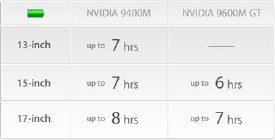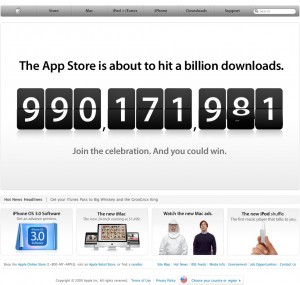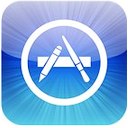 Windows 7: Loading soon in a PC near youMicrosoft is still reeling from the fiasco that was Windows Vista. 2008 for them was really all about dodging the backlash from customers and PC manufacturers who turned to Linux or offered, “upgrades” to Windows XP on new Vista machines.
The Mac vs. PC advertisements, which poked fun at Vista’s shortcomings, eventually led to Microsoft’s rebuttal in the form of the “I am a PC” ads, which gave a more human face to PC users. This didn’t really ease the sting from unhappy Vista users or computer resellers but it showed the software company was aware of the perception that Vista had fallen short of expectations.
Rather than continue beating a dead horse, Microsoft wisely gave advance notice of a successor to Windows Vista. Redesigned from the ground up, the new version made it to public beta recently.
More on Windows 7 after the jump.
A New Hope
Windows 7, which is supposed to make it to market late this year, carries with it the hopes of millions of users. It is supposed to be the breakthrough OS that patches all of Vista’s flaws and offers what Microsoft is calling, “a major Windows release.”
Will 2009 be the year of redemption for Windows, it remains to be seen but for now we can gloss over the features and improvements that lucky 7, Windows that is, will be bringing to market.
Multi-touch technology, currently making waves in iPods, tablets and some smartphones, will be integrated into Windows 7; we see this as a handy feature for Tablet PC users or for touch screen enabled notebooks. Multi-touch is a great party trick and does have some uses but for most mainstream users it isn’t a big deal.
Users will see more of the new Windows Shell with a new taskbar, a spiffy home networking system called HomeGroup and performance improvements. A lot of the applications that Microsoft used to include in Vista, will be cast away from the system to trim the fat and give users a more solid OS that requires less storage space.
Fans of Windows Mail, Windows Movie Maker and Windows Photo Gallery might miss these built-in apps but the rest of us can rejoice their departure. You will still be able to get them separately as part of the Windows Live Essentials suite, part of Microsoft’s cloud computing initiative of offering applications online.
Windows 7 users will also see updated versions of Paint and WordPad plus more things to tweak in the Control Panel including Accelerators, ClearType text tuner, Display Color Calibration, Gadgets, Infrared, Recovery, Troubleshooting, Workspaces Center, Location and Other Sensors. Expect upgraded functionality on the Start Menu and the rest of the taskbar that will now be called the Superbar and will feature Jump Lists that is a way of accessing common tasks.
Lean and Able
Microsoft wants to make sure that Windows 7 is as lean an operating system as it can possibly be. Aside from ditching all the add-ons which users don’t really need, they are supposedly streamlining the code to trim out the bloat that has swelled up since the days of Windows 3.1.
The result is that Windows 7 will run well in machines that Windows Vista could not. It remains to be seen if Windows 7 will have as many versions as Windows Vista did, hopefully Microsoft will just offer a home and a professional (business) version like they did with Windows XP. This is exceptional news for the netbook crowd who are stuck in XP land simply because Vista is too bloated to function on stripped down systems. Newer PCs like Sony's new VAIO P have been proven to run Windows 7 quite well despite choking on Windows Vista Home.
One thing is certain, Microsoft has learned their lesson and won’t be shipping a product that is premature and still buggy. If it has learned anything about the painful Windows Vista experience, it is that the extra time taken to refine a product can only make things better.
Shipping something that “just works,” is less expensive than constantly patching unfinished and buggy software. Users will finally be getting the efficient and stable OS they deserve.
Windows 7: Loading soon in a PC near youMicrosoft is still reeling from the fiasco that was Windows Vista. 2008 for them was really all about dodging the backlash from customers and PC manufacturers who turned to Linux or offered, “upgrades” to Windows XP on new Vista machines.
The Mac vs. PC advertisements, which poked fun at Vista’s shortcomings, eventually led to Microsoft’s rebuttal in the form of the “I am a PC” ads, which gave a more human face to PC users. This didn’t really ease the sting from unhappy Vista users or computer resellers but it showed the software company was aware of the perception that Vista had fallen short of expectations.
Rather than continue beating a dead horse, Microsoft wisely gave advance notice of a successor to Windows Vista. Redesigned from the ground up, the new version made it to public beta recently.
More on Windows 7 after the jump.
A New Hope
Windows 7, which is supposed to make it to market late this year, carries with it the hopes of millions of users. It is supposed to be the breakthrough OS that patches all of Vista’s flaws and offers what Microsoft is calling, “a major Windows release.”
Will 2009 be the year of redemption for Windows, it remains to be seen but for now we can gloss over the features and improvements that lucky 7, Windows that is, will be bringing to market.
Multi-touch technology, currently making waves in iPods, tablets and some smartphones, will be integrated into Windows 7; we see this as a handy feature for Tablet PC users or for touch screen enabled notebooks. Multi-touch is a great party trick and does have some uses but for most mainstream users it isn’t a big deal.
Users will see more of the new Windows Shell with a new taskbar, a spiffy home networking system called HomeGroup and performance improvements. A lot of the applications that Microsoft used to include in Vista, will be cast away from the system to trim the fat and give users a more solid OS that requires less storage space.
Fans of Windows Mail, Windows Movie Maker and Windows Photo Gallery might miss these built-in apps but the rest of us can rejoice their departure. You will still be able to get them separately as part of the Windows Live Essentials suite, part of Microsoft’s cloud computing initiative of offering applications online.
Windows 7 users will also see updated versions of Paint and WordPad plus more things to tweak in the Control Panel including Accelerators, ClearType text tuner, Display Color Calibration, Gadgets, Infrared, Recovery, Troubleshooting, Workspaces Center, Location and Other Sensors. Expect upgraded functionality on the Start Menu and the rest of the taskbar that will now be called the Superbar and will feature Jump Lists that is a way of accessing common tasks.
Lean and Able
Microsoft wants to make sure that Windows 7 is as lean an operating system as it can possibly be. Aside from ditching all the add-ons which users don’t really need, they are supposedly streamlining the code to trim out the bloat that has swelled up since the days of Windows 3.1.
The result is that Windows 7 will run well in machines that Windows Vista could not. It remains to be seen if Windows 7 will have as many versions as Windows Vista did, hopefully Microsoft will just offer a home and a professional (business) version like they did with Windows XP. This is exceptional news for the netbook crowd who are stuck in XP land simply because Vista is too bloated to function on stripped down systems. Newer PCs like Sony's new VAIO P have been proven to run Windows 7 quite well despite choking on Windows Vista Home.
One thing is certain, Microsoft has learned their lesson and won’t be shipping a product that is premature and still buggy. If it has learned anything about the painful Windows Vista experience, it is that the extra time taken to refine a product can only make things better.
Shipping something that “just works,” is less expensive than constantly patching unfinished and buggy software. Users will finally be getting the efficient and stable OS they deserve.
Click to read more ...
 Wednesday, June 10, 2009 at 11:14AM
Wednesday, June 10, 2009 at 11:14AM  Gadjo Cardenas Sevilla
Adding faster processors, larger memory capacities (up to 8GB), FireWire 800 plus a SD Card Slot, Apple refreshed its MacBook Pro line by formally inviting the unibody 13’ inch MacBook to the fold. More after the break.
Available in Canada this week, the new MacBook Pro 13 starts at $1,399, offers a backlit keyboard, a 2.26GHz Core 2 Duo processor, 2GB of RAM, 160GB HD and most surprisingly a built in 7-hour battery (non-user removable). A 2.56GHz model is available for $1,749 and offers a 250GB hard drive and 4GB of RAM.
Gadjo Cardenas Sevilla
Adding faster processors, larger memory capacities (up to 8GB), FireWire 800 plus a SD Card Slot, Apple refreshed its MacBook Pro line by formally inviting the unibody 13’ inch MacBook to the fold. More after the break.
Available in Canada this week, the new MacBook Pro 13 starts at $1,399, offers a backlit keyboard, a 2.26GHz Core 2 Duo processor, 2GB of RAM, 160GB HD and most surprisingly a built in 7-hour battery (non-user removable). A 2.56GHz model is available for $1,749 and offers a 250GB hard drive and 4GB of RAM.
 The entire Macbook Pro line now has improved battery life, thanks to an innovative but non-user replaceable battery that was introduced in last year’s MacBook Air. The addition of a Firewire 800 port on the 13’ inch MacBook is also a welcome addition that many users were clamoring for.
For the 15-inch MacBook Pro, a new 7-hour battery (built-in), a 3.53GHz, 2.66GHz or a 2.8GHz processor with 4GB RAM (upgradeable to 8GB), up to 500GB hard drive capacities. NVDIA GeForce 9400M is standard on the base model. You can still get the white polycarbonate MacBook, which is a great value at $1149.00 and offers a 2.13Ghz processor, 2GB RAM and a 160GB Hard Drive.
Apple also announced the availability of Snow Leopard for a surprising price of $29.00. $100 less than previous OS X updates. Snow Leopard will be available in September. One month before Microsoft’s Windows 7 is released. Snow Leopard is an evolutionary upgrade to the Mac OS and will be faster to install than the previous version and will also reclaim around 6GB of disk space.
Offering reduced prices on its most popular hardware and its operating system shows that Apple Inc. is seriously challenging the perception that they are expensive and out of reach.
The entire Macbook Pro line now has improved battery life, thanks to an innovative but non-user replaceable battery that was introduced in last year’s MacBook Air. The addition of a Firewire 800 port on the 13’ inch MacBook is also a welcome addition that many users were clamoring for.
For the 15-inch MacBook Pro, a new 7-hour battery (built-in), a 3.53GHz, 2.66GHz or a 2.8GHz processor with 4GB RAM (upgradeable to 8GB), up to 500GB hard drive capacities. NVDIA GeForce 9400M is standard on the base model. You can still get the white polycarbonate MacBook, which is a great value at $1149.00 and offers a 2.13Ghz processor, 2GB RAM and a 160GB Hard Drive.
Apple also announced the availability of Snow Leopard for a surprising price of $29.00. $100 less than previous OS X updates. Snow Leopard will be available in September. One month before Microsoft’s Windows 7 is released. Snow Leopard is an evolutionary upgrade to the Mac OS and will be faster to install than the previous version and will also reclaim around 6GB of disk space.
Offering reduced prices on its most popular hardware and its operating system shows that Apple Inc. is seriously challenging the perception that they are expensive and out of reach.
























 Purchasing these movies is easy provided you have an existing account; in fact we would say that it is too easy to be renting movies left and right. Standard definition versions are rented for between US$ 1.00 to US$ 5.00 depending on how new they are – movies can also be purchased for roughly $10.00. The selection isn't bad but the library is being added on to on a constant basis. It sure beats having to toggle with that awful
Purchasing these movies is easy provided you have an existing account; in fact we would say that it is too easy to be renting movies left and right. Standard definition versions are rented for between US$ 1.00 to US$ 5.00 depending on how new they are – movies can also be purchased for roughly $10.00. The selection isn't bad but the library is being added on to on a constant basis. It sure beats having to toggle with that awful 
